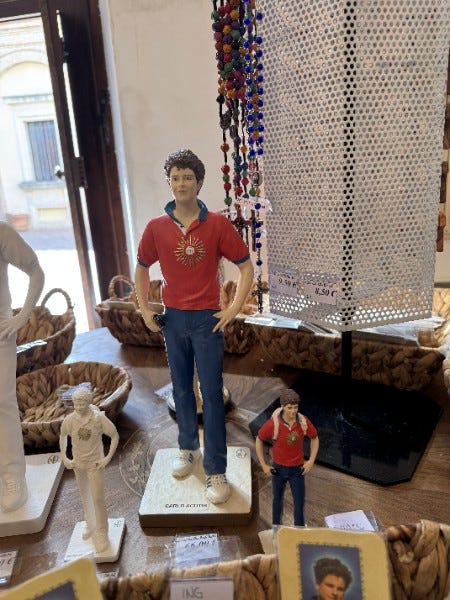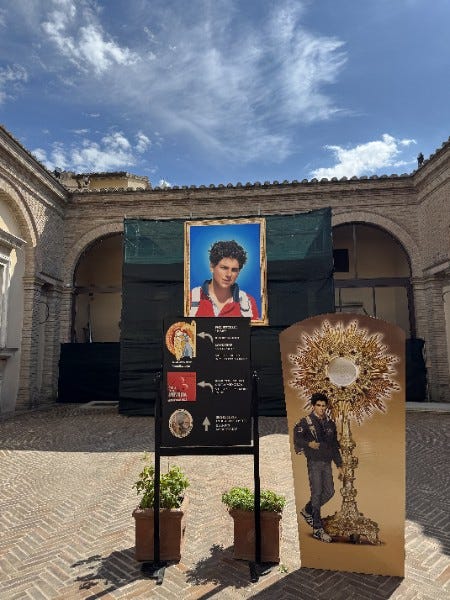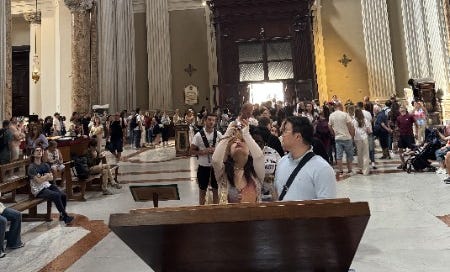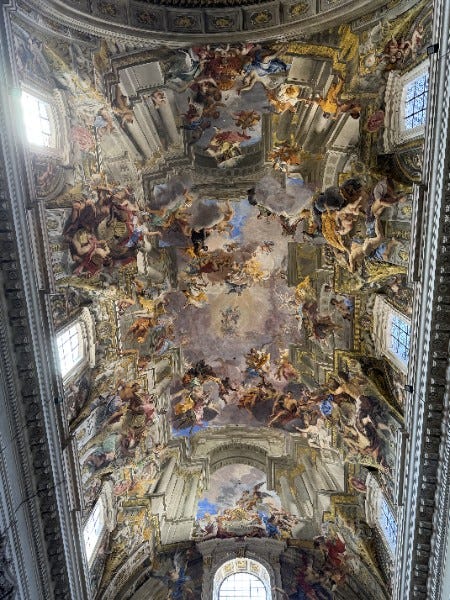“God’s Influencer” How Digital Content Creators are Changing a Religious Institution
The Millennial Saint and Instagram influencers may be the most powerful ‘cultural creatives’ since the artists of the Counter Reformation.
I can't think of an institution more stodgy, ancient, and out of touch with youth culture than the Catholic Church. After all, it's 2,000 years old and certainly feels like it, and has since I was an altar boy who was focused more on soccer games and skateboarding than the stations of the cross. There was something about the Renaissance artwork, old paintings, and ancient vestments that made me feel surrounded by antiquity. In truth, maybe that was part of the appeal, much like the way banks used to have huge stone pillars out front to project an aura of permanence and comfort, a safe place to invest your most important things.
But society has changed as dramatically from when I was twelve years old to now as it did from the Council of Nicaea to Vatican II in the 1960s. Banks don't even have physical locations in the digital age, let alone need stone pillars.
So, how does an ancient institution with a medieval aesthetic connect with Instagram influencers and TikTokers?
Funny you should ask.
The Catholic Church, an institution rightfully viewed as traditional and resistant to change, has actually undergone a remarkable digital transformation in recent years. This shift represents a fundamental recognition that effective evangelization must meet people where they are, and for many young people today, that means online.
I will talk about these "accessible ways" in a moment, and the two remarkable events that happened during my trip to Italy that shocked me and took time to process.
First, some context.
Young adults in their twenties and thirties are becoming Catholic at incredible rates, with dioceses reporting dramatic increases in adult conversions, some experiencing year-over-year growth of 50% to 70%. At least three-quarters of new converts are in their 20s or early 30s, representing a remarkable demographic shift that has accelerated since the pandemic. Significantly, many of these new believers cite discovering the Church through the internet, particularly through YouTube content creators and social media platforms that explain Catholic theology in accessible ways.
This phenomenon reflects broader changes in Catholic demographics. The global Catholic population has grown to 1.406 billion in 2023, with a 1.15% increase from the previous year, while America has gained 2.9 million Catholics since 2010 despite losing 1,200 churches. These statistics suggest that while institutional structures may be consolidating, the faith itself is expanding, particularly among younger generations who are finding new pathways to belief.
This digital transformation didn't emerge in a vacuum. Pope Francis, who passed away in April 2025, spent his pontificate deliberately reaching out to young people in unprecedented ways. Through his post-synodal apostolic exhortation "Christus Vivit" (Christ Lives), Francis challenged the Church to see young people not merely as the "future of the Church" but as the "living hope of a missionary church" in the present. His approach recognized that 60% of Catholics under 18 in the United States are Hispanic, reflecting the Church's increasingly diverse and youthful demographic.
The late Pope's legacy of inclusion and authentic engagement with youth culture laid the groundwork for the digital revolution we see today. When 200,000 young Catholics gathered at St. Peter's Square to mourn Francis just days after his death, it demonstrated the profound connection he had forged with younger generations. As one young Catholic reflected, Francis showed them "God's mercy in action" and "emphasized the importance of listening to others," treating young Catholics as "vital members of the Church" rather than passive recipients of doctrine.
The election of Pope Leo XIV, Cardinal Robert Prevost, the first American pontiff in history, signals a continuation and likely acceleration of this youth-focused approach. Selected by the largest and most diverse conclave in Church history, Leo XIV has already shown early signs of capitalizing on what observers call "a moment of euphoria for Catholics," particularly in building bridges within a divided Church.
While still early in his pontificate, Leo XIV's background suggests an understanding of the American Church's unique position in global Catholicism. His selection comes at a time when traditionally Catholic European countries face declining numbers, while the developing world, where more than two-thirds of Catholics now live, continues to grow. This demographic reality, combined with the surge in young adult conversions in the United States, positions Leo XIV to potentially lead a new era of evangelization that seamlessly blends digital innovation with pastoral care.
This convergence of papal leadership, demographic shifts, and digital opportunity creates the perfect opportunity for institutional transformation. Understanding this evolution intellectually is one thing; witnessing it unfold in the sacred spaces of Rome itself is quite another. It was during my journey through Italy that I encountered two vivid examples of how this digital revolution is reshaping the very experience of Catholic worship and pilgrimage, moments that forced me to grapple with what it means when ancient sanctuaries embrace the language of social media.
I want to talk about this for a moment. The first happened in Rome, specifically at my favorite cathedral in the world, Chiesa del Gesù, better known as the Jesuit Cathedral, the mother church of the Jesuit Order. If you've never been, you owe it to yourself to put it on your must-see list. It's a short walk from the Pantheon, and its extraordinary ceiling rivals any artwork in Christendom.
But here's the thing: I've never seen a line to get into it, and on this late afternoon, there was a line, a long one. Or more accurately, there was a long, snaking line to get in, though I discovered you could skip it entirely and walk right in.
So if you could just walk right in, why was there a line?
Here's where it got interesting.
The line was for people waiting to spend one euro to light up the cathedral ceiling and use a mirror that reflected the ceiling, creating the perfect Instagram video. That's it. Rather than using the old-school technique of tilting your head back to stare at the heavens, the way artists intended, Instagram influencers were invited to be their best selves with the assistance of a mirror and their phone to post an Instagram-worthy video of something already awe-strikingly magnificent.
At first, I was shocked. Then, a little angry. Then disappointed. Then heartbroken.
And not just because the Church needed to reduce one of the world's great masterpieces to being "Insta-worthy." I felt more heartbroken for a young generation who seemingly could only experience great culture through the filter of their phones.
What are we becoming?
To answer this question, I did a little research. It turns out the Vatican has issued comprehensive guidance recognizing social media as "a powerful means of evangelization" and encouraging Catholics to bring Church teachings into what Pope Benedict XVI called "the digital continent." This approach acknowledges that there are now more active Facebook accounts than there are Catholics worldwide, representing an enormous evangelization opportunity.
Catholic content creators have emerged as influential voices. Figures like Cameron Bertuzzi, whose own conversion to Catholicism has inspired thousands through detailed theological explanations and discussions of Church history, exemplify this trend. Father Simon Esshaki built 470,000 TikTok followers by meeting young people in the digital spaces they already inhabit.
Perhaps no initiative better illustrates the Church's internet culture strategy than the Vatican's introduction of "Luce," an anime-style mascot for the 2025 Jubilee year. Within a week of its debut, Luce became a viral internet sensation, with hundreds of memes and fan art renditions appearing across social media platforms, demonstrating how the Church can successfully adapt contemporary visual languages.
The Church's approach isn't merely about adopting new platforms but thoughtfully engaging with digital culture's unique characteristics. Vatican guidance emphasizes the importance of "listening with the ear of the heart" in digital spaces and recognizing that effective online communication requires authenticity and genuine relationship-building rather than superficial content distribution.
Studies reveal that 83% of Catholic youth use the internet daily, mostly through social networks like Facebook and YouTube. However, research also indicates that the Catholic Church must become more aggressive in utilizing new media and programming messages specifically toward younger generations, as many feel the Church has "failed to program toward youth" effectively.
This digital strategy represents a profound shift from traditional evangelization methods. Rather than waiting for young people to come to church buildings, the Church is proactively entering the digital spaces where youth naturally congregate. The strategy recognizes different audience segments, from tech-savvy Catholic youth groups to potential new members who might be "one inspirational meme away from joining the flock."
If you're still with me, here's where things got really fascinating. In the small Italian village of Assisi, home to one of the most revered Catholic saints, Francis, the second unexpected thing happened on my journey.
It was in this tiny town that I came to know Carlo Acutis. Remember that name if you haven't heard it already, because shortly, this name will be known worldwide.
Carlo Acutis was a devout Catholic who passed away at the tender age of 15. Born in 1991 and dying of leukemia in 2006, Carlo was by all accounts an extraordinarily devout Catholic who served as an altar boy and volunteered at local parishes, building websites and helping to engage young people of faith in the early days of the internet.
For brevity's sake, I'll link to Carlo Acutis's story here. Suffice it to say, he went through the rigid, structured process of beatification and was on his way to sainthood. On July 1, 2024, Pope Francis presided at an ordinary consistory of cardinals, which approved the canonization of 15 people, including Blessed Carlo Acutis. On November 20, 2024, it was announced that Acutis would be canonized during the 2025 Jubilee, specifically during the Jubilee of Teenagers from April 25 to 27, 2025, with the Diocese of Assisi confirming it would be on Sunday, April 27. However, following Pope Francis's death on Easter Monday, April 21, 2025, the Vatican announced that the ceremony would be postponed without providing a new date.
Carlo Acutis is known as the first "gamer saint" and "God's influencer." Now that's modern marketing!


This also explains the activity I witnessed at the Jesuit Cathedral in Rome. This institution isn't considering social media a fad, they're treating it as critically as they did when they conscripted Michelangelo to paint the altar wall of the Sistine Chapel during the Counter-Reformation. In fact, the first "Catholic creators" were Michelangelo, Raphael, Botticelli, and Peter Paul Rubens. Today, with the canonization of 15-year-old Carlo Acutis, the Catholic Church begins a new age.
The Catholic Church's embrace of internet culture demonstrates that even ancient institutions can adapt to contemporary communication methods while maintaining their core message. By meeting young people in digital spaces with authentic content, visual creativity, and genuine engagement, the Church is successfully bridging the gap between timeless spiritual truths and modern cultural expression, creating new pathways for faith formation in the digital age.








If the young Hispanic population continues to blend with digital innovation that would fly directly in the face of these tech bros power grab that they've had on us since at least 2015 and that they have no intention of stopping. Because young Hispanics are the fastest growing demographic in the United States, a shift in the massive manipulation of tech bros stealing elections (Brexit, 2016, etc.), the influence of young Hispanics in the digital world could turn Silicon Valley on its head. Young Hispanics could turn social media into what it was originally intended to be: a community where people unify and find common ground instead of the rage inducing divider it has turned into.
Wow.
I'll be marinating on this most of my day today because I know, or rather have a sense that, our elections may be turning away from the darkness we've known for far too long.
The Latino Century has arrived and I am def here for it.
Meeting people where they are! I guess I shouldn’t be surprised that an institution as old and experienced as Catholicism should have a long view and be so surprisingly progressive in its wisdom and advocation of Christ. I’m impressed.